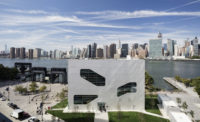Steven Holl Prevails in Global Competitions
Architect Steven Holl might not have nabbed this year’s Pritzker Prize, like some predicted he would, but he is on a winning streak nonetheless.
Click on the slide show icon to see additional photos.
Last fall, he won an international competition to design a new building at the Glasgow School of Art, alongside Charles Rennie Mackintosh’s masterpiece. More recently, he was victorious in two competitions: one commission is for a campus building in Iowa, the other a sweeping master plan for an industrial section of Hangzhou, China.
Although the scales and locations couldn’t be more dissimilar, both try to honor their surroundings, says Chris McVoy, a senior partner with Steven Holl Architects, which is based in New York City. “These are both very different projects but have great potential to engage the landscape,” he says. (Holl was traveling overseas and unavailable for comment.).
Of the two projects, the Hangzhou International Tourism Complex, as it’s called, is further along in the design process. Encompassing a bowtie-shaped parcel where factories churn out boilers and oxygen tanks, the plan calls for apartments, shops, and offices across a 60-acre canal-lined site.
The scheme, which beat out one from second-place-finisher Herzog and de Meuron and third-place David Chipperfield, divides the site into thematic “water” and “mountain” zones.
On the water side will rise nine 18-story apartment towers whose southern Fresnel glass facades will glow yellow at night, courtesy of photovoltaics. Encircling the towers’ bases will be a large pool fed by the canal, which is to be significantly expanded and widened. A shopping mall will be located under the towers.
The mountain side, meanwhile, will offer a hotel called “3D Park,” which refers to the fact that its low-slung ramp-shaped structure, whose roof is planted and traversable, resembles a peeled-back slice of earth. Connected to the hotel is an existing boiler factory, which will become an event venue. Seven additional factories on the site will be preserved.
The plan’s most striking feature is the two high-rises standing where the zones meet. One, with a crinkled rock-face-like ceramic skin will be a hotel. The other, smooth and cylindrical, will have offices. They will be joined at mid-point by an enclosed and inclined escalator and, at their base, by a podium containing shops and parking.
In addition, 18 apartment buildings resembling boxcars, many separated by fingers of new waterways, will rib the site’s narrowest section.
“Holl took some very familiar elements from the existing historical landscape, broke them down into their constituent parts and represented them on an urban scale,” says Terry Riley, of Keenen/Riley Architects, who was part of the nine-member jury that selected the plan, along with Thom Mayne, Ralph Lerner, and Wolf Prix. “There was a very positive reaction to that,” Riley adds.
While Holl has undertaken projects in Biarritz (France), Berlin, and Beirut, as well as throughout China, he’s perhaps best known for his work at U.S. institutions, like the Nelson-Atkins Museum of Art or Massachusetts Institute of Technology, home to Simmons Hall, a dorm.
In that sense, his other prize, to design an arts center for the University of Iowa, in Iowa City, puts him in familiar territory.
On February 4, the university announced that Holl, along with Berkebile Nelson Immenschuh McDowell Architects (BNIM) of Kansas City, had won the commission to design the center, which will replace one damaged by the adjacent Iowa River in 2008, when it burst its banks.
Though the new center, with 113,000 square feet, will be roughly the size of the current one, whose oldest section dates to 1936, it will sit much higher on a bluff above the river’s bank, said Beverly Robalino, the university’s project manager. The Federal Emergency Management Agency will pick up 90 percent of the construction tab, she added.
What the new center will look like, however, is uncertain. The competition, which drew 22 submissions, required only that applicants submit examples of relevant projects, which bode well for Holl.
In 2006, he designed the university’s Art Building West, a nearby 70,000-square-foot facility clad in Cor-Ten steel whose library portion is cantilevered over a pond. (Even though the building’s systems were damaged by floodwaters, the actual structure was minimally affected, Robalino says.)
For Rod Kruse, FAIA, a principal in the Des Moines office of BNIM, the university’s familiarity with Holl’s work helped seal the deal.
“The school’s been working in a piece of contemporary art for a few years,” says Kruse, who helped Holl design Art Building West while working for his previous employer, Herbert Lewis Kruse Blunck Architecture, which is based in Des Moines. “If we hadn’t had that success, it would have been tougher to be picked.”




